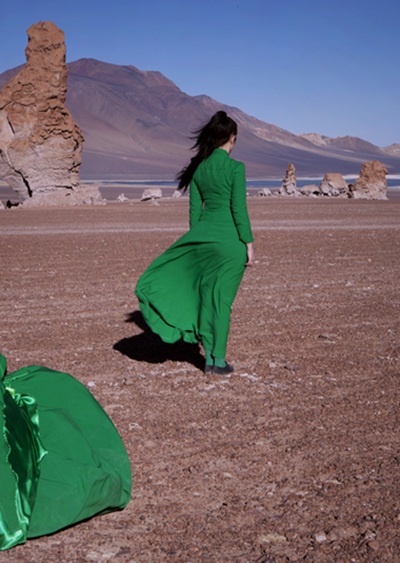
On 14 December, the EMΣT launches its next series of exhibitions entitled What if women ruled the world? The new cycle of exhibitions begins with a new proposal to present the Museum’s collection on the third floor, entitled WOMEN, Together. For the next seven months, women take over the National Museum of Contemporary Art Athens, as the spaces are exclusively dedicated to works by women artists and creators who identify themselves as women. The National Museum of Contemporary Art Athens becomes the first contemporary art museum in the world to propose, promote and defend such a dynamic initiative dedicated to women’s creation and expression.
“This is the first time”, stresses Katerina Gregou, Artistic Director of the ΕΜΣΤ, “that a public museum exhibits exclusively the works of women artists, not only in the exhibition of its collection but also in all the spaces of its temporary exhibitions”. She continues: “Our intention and goal is to transcend the dominant narrative and symbolically, and not only, subvert that reality of the chronic underrepresentation of women creators in all fields of art. The question we pose in the Museum’s new cycle of exhibitions is an occasion for a broader reflection. What would happen, really, if women ruled the world? And what form would museums take if women had taken their rightful place in the history of contemporary art?”
In the context of the exhibition renewal of the collection, the first presentation of a number of works from the D.Daskalopoulos Collection Donation, the most important donation in the Museum’s history since its foundation, will take place, together with works from the ΕΜΣΤ collection.
Works by artists such as: Ghada Amer, Helene Appel, Bertille Bak, Karla Black, Hera Buyucktasciyan, Marina Gioti, Diana Al Hadid, Tala Madani, Annette Messager, Tracey Moffatt, Eleni Mylona , Cornelia Parker, Agnieszka Polska, Christianna Soulou, Aspa Stasinopoulou, Maria Tsaggari, Gillian Wearing κ.ά.
The presentation also includes the new long-term loan of an important work by Etel Adnan, courtesy of SARADAR COLLECTION, Paris/Beirut.
During the same period, and for three days, a series of performances by leading performance artist Alexis Blake, winner of the Prix de Rome, will be presented at the Museum. These performances mark the artist’s first presentation in Greece. Blake’s work brings together the visual arts, performance and dance, exploring the way in which the body is represented and treated as an archive, which the artist then examines and renegotiates. Her work directly engages with the representation and subjectification of women’s bodies, while activating them as agents of resistance. Blake presents her iconic performance Allegory of the Painted Woman, for two dancers and four musicians, which challenges the archetypal, patriarchal depiction of women in art history.
Curated by: Anna Mykoniati
RETROSPECTIVE ON LEDA PAPAKONSTANTINOU’S WORK
|
On 14 December, the EMΣT opens the first major retrospective exhibition of Leda Papakonstantinou (1945), one of the most influential artists in the history of contemporary art in Greece and one of the pioneers of feminist art in our country. For almost five decades, Papakonstantinou developed a multifaceted and multidimensional oeuvre. Always focusing on the body, her work includes performance, sculpture, video, site-specific installations and painting. Issues of gender, sexuality, collective and personal memory, history, politics and ecology are at the core of her artistic expression. Her work as a whole is a reference point for Greek art, as well as a source of inspiration for younger visual artists.
Showroom -1
Curated by: Τina Pandi
CHRYSAROMANOU
|
On 14 December, the EMΣT will also inaugurate an exhibition dedicated to the work of CHRYSA ROMANOU (1931-2006) – one of the most recognizable and acclaimed Greek artists of her generation. Her stay in France from 1961 to 1981 was decisive for the formation of her artistic identity. She belonged to the group of Greek artists of the diaspora who lived and worked in the great art centres of the Western world after the war. For the first time in the history of Greek art, a woman artist, Chrysa Romanou, did not simply follow international artistic developments but co-shaped them. Perhaps best known for her collages, which, with critical insight, combined advertisements and images from the media and consumer culture to comment on the political and social realities of her time, Romanou’s uncompromising gaze remains sharp and relevant, even today.
Showroom of the 4th floor
Curated by: Eleni Koukou and Dimitris Tsoumplekas
DANAIANESIADOY
|
On the same day, the EMΣΤ also inaugurates the first solo exhibition in Greece of the Belgian-Greek artist Danai Anesiadou, D-POSESSIONS. Born in Germany to parents of Greek descent and settled in Brussels from a young age, Anesiadou has developed over the last 15 years a series of metaphysical and personal narratives in a highly personal and idiosyncratic body of work that references cinema, the occult sciences, Greek antiquity and contemporary current affairs. Armed with a keen interest in historiography and politics, she questions what we believe to be true, pointing out the double standards and false dichotomies of mainstream discourse and misinformation culture. Her solo exhibition at the EMΣT invites visitors to an allegorical scenography consisting of new sculptures and collages related to the inflation of political and intellectual crises. Like a contemporary exorcist, Anesiadou attempts to purify and transform not only her personal material possessions but also the energy flows vibrating around us.
The exhibition is co-produced with WIELS, Brussels
Showroom of the 4th floor
Curated by: Ioli Tzanetaki
10 FEBRUARY 2024
WHAT IF WOMEN RULED THE WORLD? (PART 2)
EMΣT launches eight more solo presentations of works by women artists.
On 10 February 2024, the second part of the exhibition cycle dedicated to the work of women artists will be inaugurated. It includes the retrospective exhibition of the internationally acclaimed Iranian painter TALA MADANI, as well as solo exhibitions by BOUCHRA KHALILI (Morocco), MALVINA PANAGIOTIDOU (Greece), LOLA FLASH (USA), CLAUDIA COMTE (Switzerland), YAELBARTANA (Israel), HADASSAH EMMERICH (Indonesia/Netherlands) and Prix Marcel Duchamp 2023 nominee BERTILLE BAK (France). Bertille Bak’s work launches a new programme at the Museum entitled SPOTLIGHT, which will highlight, in a solo presentation, the work of an artist from the EMΣT collection.
11 MAY 2024
WHAT IF WOMEN RULED THE WORLD? (PART 3)
PENNY SIOPIS |
The cycle will conclude with the first major museum retrospective of PENNY SIOPIS’ work, which will open on 11 May 2024. Born in South Africa in 1953 to Greek parents, Siopis became known in the early 1980s and 1990s for her feminist and historical paintings and for her active stance on both women’s rights and the resistance against apartheid. In the post-national liberation era in South Africa, her interdisciplinary practice has explored the fragility of memory, notions of truth and the complexities of personal and collective history, especially in a country like South Africa that bears the trauma of lingering racism. Working with a wide range of materials, Siopis has explored the politics of the body, grief and shame, collective history and, most recently, the relationship between the human and the non-human in the context of climate change. In the process, he has established himself as one of the most important artistic voices on the African continent and beyond, and has become an important reference and influence for artists of the younger generation. The EMΣT is proud to be able to present the artist’s work in its entirety for the first time.
Showroom -1
Curated by: Katerina Gregou
SUMMER 2024 |
The next cycle of exhibitions, following the What if women ruled the world? will open on 13 June 2024. At the centre of this cycle is the major international exhibition Why Look at Animals?, spread over two floors of the Museum, curated by Katerina Gregou, Artistic Director of the EMΣT. The exhibition is inspired by John Berger’s historical book of the same name (1980), at the core of which the relationship between humans and animals in the years of modernity is explored, as well as the gradual marginalisation of animals in human societies. Starting from this conceptual framework, the exhibition seeks to reflect on the issue of human-animal relations, such as the alienation of humans from animals or the removal of animals from their natural environment, while aiming at a public, open dialogue on the tragic fate of animals. Why Look at Animals? primarily highlights the urgent need to recognize the self-awareness and empathy of animals and their rights.










Leave A Comment